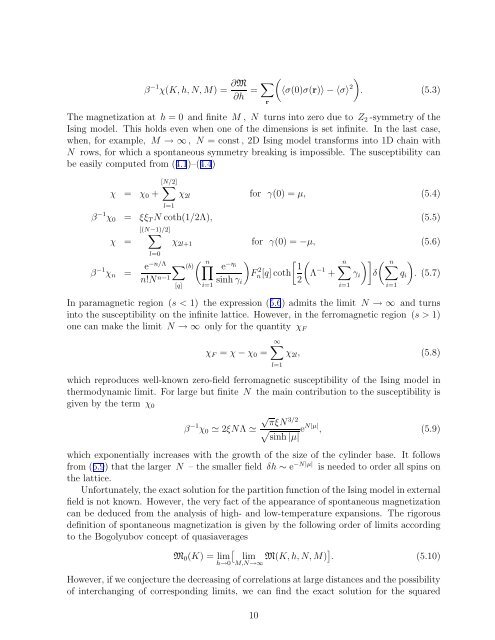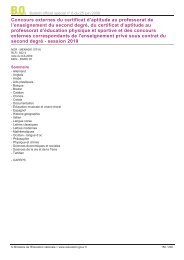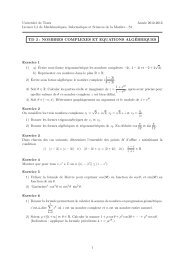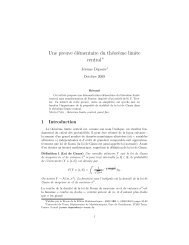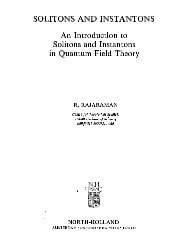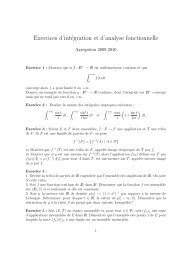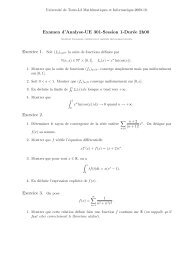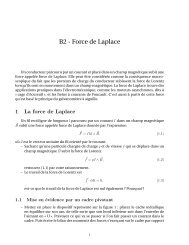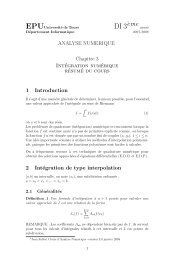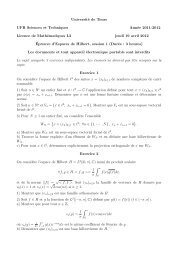Magnetic susceptibility of the two-dimensional Ising model ... - LMPT
Magnetic susceptibility of the two-dimensional Ising model ... - LMPT
Magnetic susceptibility of the two-dimensional Ising model ... - LMPT
You also want an ePaper? Increase the reach of your titles
YUMPU automatically turns print PDFs into web optimized ePapers that Google loves.
β −1 χ(K, h, N, M) = ∂M<br />
∂h = ∑ r<br />
(〈σ(0)σ(r)〉 − 〈σ〉 2 )<br />
. (5.3)<br />
The magnetization at h = 0 and finite M , N turns into zero due to Z 2 -symmetry <strong>of</strong> <strong>the</strong><br />
<strong>Ising</strong> <strong>model</strong>. This holds even when one <strong>of</strong> <strong>the</strong> dimensions is set infinite. In <strong>the</strong> last case,<br />
when, for example, M → ∞ , N = const , 2D <strong>Ising</strong> <strong>model</strong> transforms into 1D chain with<br />
N rows, for which a spontaneous symmetry breaking is impossible. The <strong>susceptibility</strong> can<br />
be easily computed from (4.1)–(4.4)<br />
χ = χ 0 +<br />
[N/2]<br />
∑<br />
l=1<br />
χ 2l for γ(0) = µ, (5.4)<br />
β −1 χ 0 = ξξ T N coth(1/2Λ), (5.5)<br />
χ =<br />
[(N−1)/2]<br />
∑<br />
l=0<br />
β −1 χ n = e−n/Λ<br />
n!N n−1 ∑<br />
χ 2l+1 for γ(0) = −µ, (5.6)<br />
[q]<br />
(b) ( n∏<br />
i=1<br />
) [<br />
e −η i 1<br />
F 2<br />
sinh γ<br />
n[q] coth Λ<br />
i 2(<br />
−1 +<br />
n∑<br />
i=1<br />
( n∑<br />
γ i<br />
)]δ q i<br />
). (5.7)<br />
i=1<br />
In paramagnetic region (s < 1) <strong>the</strong> expression (5.6) admits <strong>the</strong> limit N → ∞ and turns<br />
into <strong>the</strong> <strong>susceptibility</strong> on <strong>the</strong> infinite lattice. However, in <strong>the</strong> ferromagnetic region (s > 1)<br />
one can make <strong>the</strong> limit N → ∞ only for <strong>the</strong> quantity χ F<br />
∞∑<br />
χ F = χ − χ 0 = χ 2l , (5.8)<br />
which reproduces well-known zero-field ferromagnetic <strong>susceptibility</strong> <strong>of</strong> <strong>the</strong> <strong>Ising</strong> <strong>model</strong> in<br />
<strong>the</strong>rmodynamic limit. For large but finite N <strong>the</strong> main contribution to <strong>the</strong> <strong>susceptibility</strong> is<br />
given by <strong>the</strong> term χ 0<br />
√ πξN<br />
β −1 3/2<br />
χ 0 ≃ 2ξNΛ ≃ √ e N|µ| , (5.9)<br />
sinh |µ|<br />
which exponentially increases with <strong>the</strong> growth <strong>of</strong> <strong>the</strong> size <strong>of</strong> <strong>the</strong> cylinder base. It follows<br />
from (5.9) that <strong>the</strong> larger N – <strong>the</strong> smaller field δh ∼ e −N|µ| is needed to order all spins on<br />
<strong>the</strong> lattice.<br />
Unfortunately, <strong>the</strong> exact solution for <strong>the</strong> partition function <strong>of</strong> <strong>the</strong> <strong>Ising</strong> <strong>model</strong> in external<br />
field is not known. However, <strong>the</strong> very fact <strong>of</strong> <strong>the</strong> appearance <strong>of</strong> spontaneous magnetization<br />
can be deduced from <strong>the</strong> analysis <strong>of</strong> high- and low-temperature expansions. The rigorous<br />
definition <strong>of</strong> spontaneous magnetization is given by <strong>the</strong> following order <strong>of</strong> limits according<br />
to <strong>the</strong> Bogolyubov concept <strong>of</strong> quasiaverages<br />
l=1<br />
M 0 (K) = lim<br />
h→0<br />
[<br />
lim<br />
M,N→∞ M(K, h, N, M)] . (5.10)<br />
However, if we conjecture <strong>the</strong> decreasing <strong>of</strong> correlations at large distances and <strong>the</strong> possibility<br />
<strong>of</strong> interchanging <strong>of</strong> corresponding limits, we can find <strong>the</strong> exact solution for <strong>the</strong> squared<br />
10


